 W
WThis is a list of notable sausages. Sausage is a food usually made from ground meat with a skin around it. Typically, a sausage is formed in a casing traditionally made from intestine, but sometimes synthetic. Some sausages are cooked during processing and the casing may be removed after. Sausage making is a traditional food preservation technique. Sausages may be preserved.
 W
WSausages are a meat product usually made from ground meat, often pork, beef, or poultry, along with salt, spices and other flavourings. Other ingredients such as grains or breadcrumbs may be included as fillers or extenders. Some sausages include other ingredients for flavour.
 W
WThe Affair of the Sausages (1522) was the event that sparked the Reformation in Zürich. Huldrych Zwingli, pastor of Grossmünster in Zurich, Switzerland, spearheaded the event by publicly speaking in favor of eating sausage during the Lenten fast. Zwingli defended this action in a sermon called Von Erkiesen und Freiheit der Speisen, in which he argued, from the basis of Martin Luther's doctrine of sola scriptura, that "Christians are free to fast or not to fast because the Bible does not prohibit the eating of meat during Lent."
 W
WSausage casing, also known as sausage skin or simply casing, is the material that encloses the filling of a sausage. Natural casings are made from animal intestines or skin; artificial casings, introduced in the early 20th century, are made of collagen and cellulose. The material is then shaped via a continuous extrusion process – producing a single sausage casing of indefinite length – which is then cut into desired lengths, usually while the extrusion process continues.
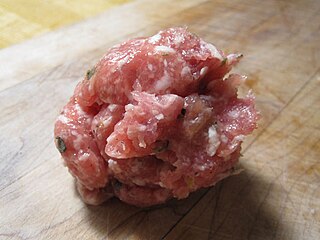 W
WGarlic sausage is a type of meat sausage prepared using garlic as a primary ingredient. It is prepared using pork or beef/veal, or a combination of pork and beef. It can be prepared using fresh or dried garlic, including dried granulated garlic.
 W
WThe Goan sausage or chorise is a typical reflection of Indo-Portuguese cuisine from Goa, Daman and Diu, which once were part of the Portuguese State of India. It is based on the chorizo sausage, introduced from Portugal. It is made with pork and various other ingredients, which make it extremely spicy.
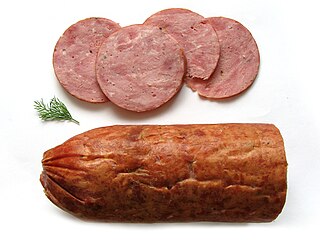 W
WHam sausage is a sausage prepared using ham and other ingredients, the latter varying by location. It is a part of the cuisines of China, Germany, Poland and the United States. Ham sausage is a mass-produced food product.
 W
WA hot dog is a grilled or steamed food consisting of a sausage served in the slit of a partially sliced bun. It can also refer to the sausage itself. The sausage used is the wiener or frankfurter. The names of these sausages also commonly refer to their assembled dish. Hot dog preparation and condiments vary worldwide. Typical condiments include mustard, ketchup, mayonnaise, relish, and cheese sauce, and common garnishes include onions, sauerkraut, jalapeños, chili, grated cheese, coleslaw, bacon, and olives. Hot dog variants include the corn dog and pigs in a blanket. The hot dog's cultural traditions include the Nathan's Hot Dog Eating Contest and the Oscar Mayer Wienermobile.
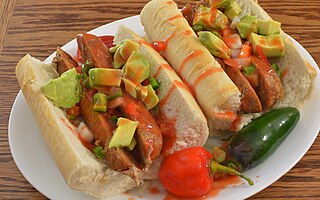 W
WA hot link, also referred to as a "red link," is a type of sausage often associated with the cuisine of the Southern United States, featured commonly as a part of American barbecue, soul food, and Cajun and Louisiana Creole cuisines. It is sometimes referred to as a "Louisiana hot link". It is also a part of Texan cuisine and the cuisine of Chicago, Illinois. The hot link is usually prepared using pork, beef, or a combination of both. It is sometimes used as an ingredient in other dishes, such as jambalaya and gumbo. Hot link sausages are mass-produced by some companies in the United States.
 W
WKielbasa is any type of meat sausage from Poland, and a staple of Polish cuisine. In American English the word typically refers to a coarse, U-shaped smoked sausage of any kind of meat, which closely resembles the Wiejska sausage in British English.
 W
WSausages are a meat product usually made from ground meat, often pork, beef, or poultry, along with salt, spices and other flavourings. Other ingredients such as grains or breadcrumbs may be included as fillers or extenders. Some sausages include other ingredients for flavour.
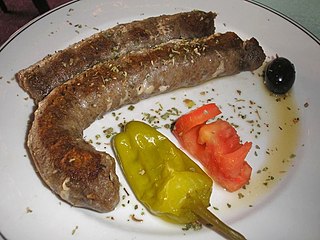 W
WLoukaniko is a type of Greek sausage made from pork or lamb and typically flavored with orange peel, fennel seed, and various other dried herbs and seeds, and sometimes smoked over aromatic woods. They are also often flavored with greens, especially leeks.
 W
WA pepperette is a sausage-like food that is usually made from ground meat, with turkey, beef, and pork being the most common varieties. The meat is usually mixed with spices and comes ready to eat without any type of cooking or preparation. Pepperettes may or may not have to be refrigerated depending on the specific type and how it was made.
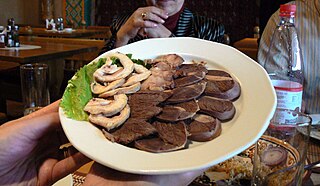 W
WQazı is a traditional sausage-like food of Kazakhs, Tatars, Kyrgyz, Uzbeks and other ethnic groups mainly of Central Asia, particularly those of Turkic origin. Kazy is a common element on a dastarkhan, a table set for a festive meal. Qazy is a dish in Kazakh and Kyrgyz cuisines made from sliced horse rib meat in an intestine casing. A reviewer from Vice (magazine) described the dish as smokey and earthy.
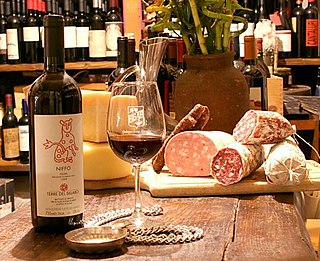 W
WSalumi is an Italian term describing the preparation of cured meat products made predominantly from pork. Salumi include bresaola, which is made from beef, and also cooked products such as mortadella and prosciutto cotto.
 W
WSausage Capital is a title carried by a number of towns around the world that are considered, or consider themselves, the makers of the best sausages in a given area. Usually the level of fame generated by this title is relatively local. The use of this sort of title is quite similar to other self-applied descriptions such as wine-making-capital, cabbage-capital, home-of-the-largest-ball-of-twine that are used by (mostly) small towns around the world, presumably to attract tourism.
 W
WThe origins of meat preservation are lost to the ages but probably began when humans began to realize the preservative value of salt. Sausage making originally developed as a means to preserve and transport meat. Primitive societies learned that dried berries and spices could be added to dried meat. The procedure of stuffing meat into casings remains basically the same today, but sausage recipes have been greatly refined and sausage making has become a highly respected culinary art.